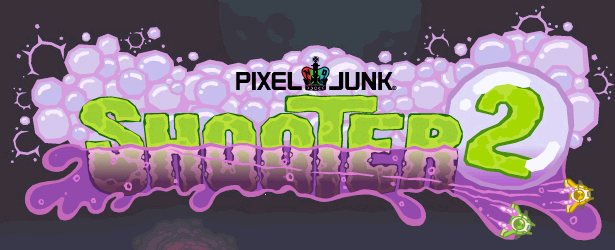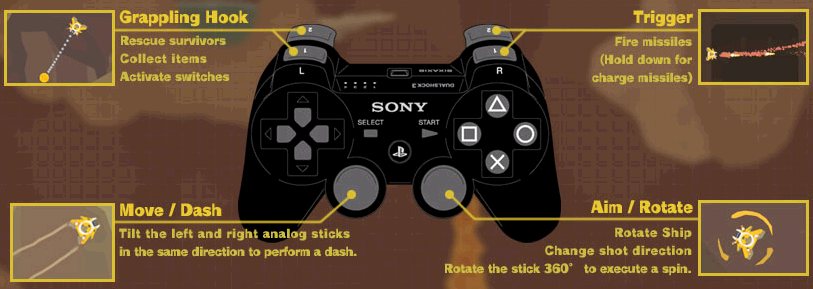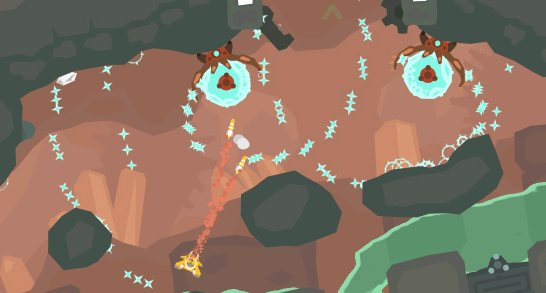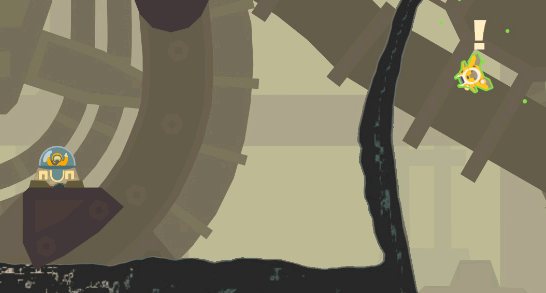Q-Games Queue: PixelJunk Shooter 2
 Friday, September 9, 2011 at 6:27PM
Friday, September 9, 2011 at 6:27PM PixelJunk Shooter 2 is the final game in my queue of Q-Games games. It is the most expensive, most technically advanced, most multiplayer featured, and most online featured game in the list. It's also a twin stick shoot-'em-up (shmup). As a eclectic SHMUP fan, my list of favorites include Defeat Me, Bangai-O Spirits, Hero Core, Ikaruga, Star Fox 64, Everday Shooter, Geometry Wars, and Sin & Punishment. So far Shooter2 is working its way onto the list. Some of its unconventional design is brilliant and refreshing, while other stylistic design choices just don't work in my view. Explaining it all is the task at hand. So, let's finish this.

There's a lot to talk about with Shooter2, but I have to say that I've only played through the adventure mode cooperatively with my brother. I haven't done any score attacks. I haven't collected all the survivors or treasures. And I haven't dipped into the competitive multiplayer. Usually I try to complete games near 100% before I write about them. But it appears that I have enough to say already. So, to prevent my Shooter2 write-up from becoming its own article series, I'll tackle many of the other modes and experiences another time.
The plan is to start with the core gameplay, then move to the level design, difficulty design, and wrap up with the short comings. Q-Games lists PixelJunk Shooter 2 as being in the "Fluid Action Shooter" genre. I'm pretty sure this sub-genre falls under the shmup umbrella. And seeing that all shmup gameplay revolves around moving and shooting a ship/character, we have the perfect entry into our analysis.
Core Gameplay

MOVE your ship by pointing the left analog stick. The ship has inertia, a feature that most shmups don't have considering that many are designed in the style of 16-bit D-pad controlled games. Shooter2 also features analog movement making full use of the analog stick technology. Use the right stick to AIM and point both both sticks in the same direction to BOOST.
SHOOT with either the right shoulder button. Tap to fire a single straight missile and hold to launch charged missiles that home targets and cause your ship to heat up. The left shoulder button shoots a GRAPPLE hook for a variety of non-lethal interactions from popping bubbles, pulling switches, and rescuing survivors. Rotate or rock the right analog stick to perform a SPIN that blocks some enemy attacks, cools down your ship faster, and can launch into a SUPER SPIN attack with the click of R3.
The core mechanics have plenty of gameplay potential. With multiple offensive, defensive, neutral, and movement options levels can be designed around a wider range of actions. Likewise, many shmups have variations of homing, shooting, and deflecting mechanics. But Shoot2's GRAPPLE is by far the most unique mechanic that Shooter2 brings to genre. Using the physics engine to allow the HOOK to move about independently of the ship, pulling, dragging, and swinging various objects and enemies are new actions in the shmup genre.
Beyond these considerations, there are co-op mechanics. The co-op designfocuses on organic cooperation. This means there are no mandatory co-op obstacles or any mechanics that get boosted when executed simultaneously. All of the tasks and roles must be assigned and maintained by the players. The only mechanics interactions between players are bumping and throwing out a life line HOOK. Like in Ikaruga, player ships can push each other just by moving against each other. This feature makes players more aware of each other and squeezing through tight situations more challenging. And if one player overheats and loses control of their ship in Shoot2, the other player can HOOK onto it to prevent it from crashing. Friendly fire is mostly off with the exception of the magma suit. So, most of the co-ounter-op harm you want to do to your teammate must be done indirectly.
One simple way to evaluate a shmup is by its bullet patterns. The linear, scripted games (Star Fox 64, Sin & Punishment, Ikaruga, etc.) are much easier to evaluate in this way versus the more emergent games (Bangai-O Spirits, Defeat Me). Shooter2 definitely falls into the latter category. With Shooter2 there isn't a lot of the classic shmup bullet patterns at all. Only the blue, flower like enemies (see image below) and the bosses launch shmup like bullet spreads. Instead, the game heavily uses physics based environmental elements to creates very emergent incoming hazards. Gas bubbles float upward, acid bubbles float in place, water and lave flow downward, and metal is influenced by magnetic fields. That's already a lot of variety, but it gets even better.
Many of my favorite shmups feature more than simple bullets. Absorbing (Ikaruga), blocking (Star Fox 64), reflecting (Bangai-O, Sin & Punishment) are mechanics that allow players to do more with bullets than simply move out of their way. Shooter2's hazardous elements feature lots of dynamic interactions between player mechanics like HOOK and SHOOT and between each other. Flowing material like lava can be shot with missiles to push it out of the way. When dangerous lava touches water, the lava cools into rock that floats in place blocking your movement. Be careful with your actions as you can start a chain reaction that may quickly get out of control. You can SPIN to redirect enemy shots and more.
The final consideration for the core gameplay is anti-spam. I've explained in my article series The Coefficient of Cleanthat a high action frequency can detract from a gameplay experience. And I've explained in my article Taking CHARGEhow mechanics like CHARGE can do wonders to break up the monotony of rapid firing. So, with any shmup I look for design features that discourage mindless spamming. In Shooter2 possibility of killing a survivor scattered throughout each floor is enough to discourage reckless shooting. After all, if too many die it's game over. Shooter2 also features a score-combo system that rewards careful aiming and letting enemies survive until just the right time. More on this later.
Level Design

Thematically, the levels are designed around the innards of a worm beast, an industrial mining factory, and haunted ghost caverns. While not altogether unique in the grand scheme of themes, these venues are refreshing for shmups and work together in an organic whole.
Structurally, each level is quite large. If you're coming from a Super Mario Brothers perspective, each level in Shooter2 is like a world in the NES Mario game. Basically, each level in Shooter2 is a series of 5 "floors" made up of many individual sections fitted into one large scrolling screen. This design focuses and streamlines the level design into manageable chunks. Each floor contains survivors, treasures, secrets, enemies, and powerup suits that only apply to that floor. Each floor is locked away behind survivor keys. Typically, players must collect every living survivors on each floor to open the exit gate.
The twin stick controls allow for simultaneous aiming and moving in any direction, and so the levels were designed to complement these mechanics through varied paths. Curved intestine like walls undulate after being shot. Pathways open and close vertically due to reverse peristalsis motions. Grinding gears slide back and forth diagonally on mechanical rails. These elements create a wide range of obstacles and pathways that the player must maneuver through. As you travel through each floor you'll often back track through tunnels and pathways. To keep things interesting, new enemies are spawned into the level to create new challenges. With the environmental puzzles and treasures to collect, each level is packed with content.
Difficulty Design
Many shmups have innovated away from the "1-hit-KOwith a limited set of lives to beat the entire game" type design. Shooter2 uses an over heating system that's a twist on the popular replenishing health design. Getting hit by magma or enemy shots greatly heats up your ship. If you reach the limit, your ship will catch on fire and lose most of its control. In this limited state you can still hope to steer toward water or star points to cool back down. This design allows for more variety and interplay between the player and enemy elements. You'll still instantly explode if you collide with an enemy's body, get crushed by a rock, or run into a few other hazards. But you can take a few hits from weaker attacks or a glancing blow from a hazardous liquid and keep fighting. Overall, the health design works well with the dynamic, interactive environments and fluids.
In single player, dying puts you back to the start of the floor. I believe you have an infinite number of trys to get through a level. Over your multiple attempts, if you let 5 survivors die, then it's game over. In co-op, like with most games, the difficulty is lessened. When a player dies in co-op, as long as they other stays alive, the dead player will respawn in a matter of seconds. For players seeking a greater challenge, there's always the multiplayer mode and the score runs.
To get a high score players must beat each level as quickly as possible, with as many survivors as possible, and by earning as many points as possible. Maximizing each of these targets brings out the best in Shooter2's level design and gameplay. Pushing through a level more quickly often means more careful maneuvering through hazards using the BOOST mechanic instead of just waiting around for the coast to clear. The lowest times may also require players to multitask and layer up challenges on a floor that run on their own organic timers (see video above). Since survivors are the keys that unlock progress through the levels and they give a whopping 1000 points for each saved, they are important parts of a high score strategy. However, they also extend the combo timer for a brilliant risk-reward design feature. Essentially rescuing survivors is a great way to bridge enemies sections that are too far away to keep a combo going. But, in many cases keeping the survivors around to be used as bridges means leaving them in harms way. So as players push through the level to clear pathways and lure enemies, keeping the survivors around takes even more skill as players have to plan for more layered, emergent possibilities. Doing so in turn puts a greater stress on efficient execution and possibly underused mechanics like SPIN.
The Shortcomings

Co-op is a great addition to PixelJunkShooter 2. I love the co-op mechanics, the emergent co-op strategies, and how several parts in the game force either my brother or me to take up specialized roles (mostly based on who got to the suit machine first). However, there are issues that shared screen co-op games tend to have and Shooter2 does not solve them. Unlike LittleBigPlanet, both players must stay on the screen in Shooter2. This means that when moving in opposite directions, players can prevent each other from progressing. This design lead to awkward moments when my overheated, burning, ready to die ship wouldn't die because it was held up by an invisible wall. Also, when the camera adjusts to keep both players on screen, naturally each player can see less around them than if they played solo.
There are a lot of elements lacking polish mainly in audio-visual details. The sound effects for important actions are very subdued and blend in with the background of the soundscape. Collecting star points makes a very soft, almost window chime like sound. This is good because these points are not necessary for progression and are typically collected in groups creating a soft cascade of chimes. Unfortunately, collecting a treasure or a survivor makes a similar type of sound. Mario's coins and Sonic's rings make a crisp sound that sits above the soundscape because of its high pitch. But in Shooter2, I often doubted whether I rescued a survivor or if I missed grabbing a treasure. I figure, why not have the survivor say "thank you" or something distinct that matches the fiction of the game.
The entering and exiting level scenes are minimal to a fault. After the opening title screen, you simple float into view. I'm fine with a simple intro, but when I have spent the last 30 minutes navigating the bowels of a beast, I'd like something a little more distinct than a freeze frame and some text that says "stage clear." With all of the other wonderful menus and visual touches in the game, I'm sure more attention could have gone into putting a more distinct end gap on actually progressing through the game. Shooter2's "stage clear" is about as bad as the ending to Quest 64, where you hit the boss, it explodes like every other enemy in the game, and then text pops up briefly describing the ending. Or it's about as vapid as beating a level in Continuity where the screen simply fades and a sound effect of opening and closing a door plays despite there not being any animation to match.
These little touches matter, and developers like Miyamoto really understand this. Take co-op for example. When you bother to grab a friend, adventure, and struggle through challenges together, it's also important for the experience of both players to be synced up. So in New Super Mario Bros. Wii, all players are given a few seconds to all grab the flag pole and exit the level together. Or in The Legend of Zelda Four Swords for the Gamecube, all players must stand in formation together to complete the level. In Shooter2, any one player can advance through a gate, into a secret passage, or through the final exit. Because the game will either end or teleport the lagging player forward, the co-op gameplay falls a bit closer to level 3 than level 6.
The visual style and presentation can become quite cluttered. Though I love the colors, shapes, and animations of everything in the game, it's not balanced for the cleanest visual communication (at least on my TV). At times the interactive parts of the level were very difficult to distinguish from the background. Also, because of the co-op camera adjusting, it was easy for me to lose track of my ship. Unfortunately, the particle effects made locating my ship even harder. When in water, my green ship looks very similar to the surrounding blue water. And the slight to massive slow down I experienced playing co-op is something I thought I'd never see running a 2D game on the PS3.
Shooter2 lacks a focus and cohesion of the larger narrative/adventure. The game really feels like a series of mostly independent floors, arranged into groups to form levels, which were then arranged into a series to create an adventure mode. The little details like losing power suits between floors is part of the reason I say this. But the bigger issue is that the game lacks any kind of suspended or persistent element between floors let along between levels. So instead of gathering new abilities, you're the same ship from start to finish. This design isn't bad. I like games where I can strategize completely within a challenge without worrying about suspended elements. This is why I greatly prefer Advance Wars over Fire Emblem. Keep in mind that this kind of design limits the types of video game climaxes available. The last levels in Shooter2 didn't offer a recap, cumulative, challenging, or a set piece climax. The dark levels were about as creative, unique, and interesting as the other levels in the game. Fortunately, he amazing last boss qualifies as cumulative and challenging climax.
I should say, that I did not collect all the treasures so I don't know yet if there's a hidden world, level, or boss that really pulls the adventure mode together. Still, beating the game and only getting a message of "you should collect all the treasures" isn't a very good "bad ending."
I wish I had time to cover the amazing boss battles in Shooter2, but I've gone on long enough. Even though the shortcomings section was very long, the game works very well. I've never played anything like it. Congrats Q-Games.


Reader Comments